de Havilland Dragon Rapide
| DH.89 Dragon Rapide/Dominie | |
|---|---|
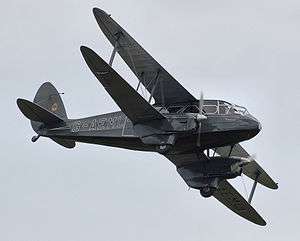 | |
| Role | Short-haul airliner |
| Manufacturer | de Havilland |
| First flight | 17 April 1934 |
| Primary user | Royal Air Force |
| Number built | 731 |
|
| |
The de Havilland DH.89 Dragon Rapide was a 1930s British short-haul biplane airliner for 6–8 passengers. It proved an economical and durable craft, despite its relatively primitive plywood construction.
Design and development
In late 1933, the Dragon Rapide was designed at the de Havilland company as a faster and more comfortable successor to the DH.84 Dragon. It was in effect a twin-engined, scaled-down version of the four-engined DH.86 Express. It shared many common features with the DH.86 Express, including its tapered wings, streamlined fairings and Gipsy Six engines but it demonstrated none of the operational vices of the Express and went on to become perhaps the most successful British-built short-haul commercial passenger aircraft of the 1930s.
Operational history
Prewar operations

On 17 April 1934, the prototype aircraft first flew at Hatfield and 205 aircraft were built for airlines and other owners all around the world, before the outbreak of World War II. Originally called the "Dragon Six" it was first marketed as "Dragon Rapide", although later it was popularly referred to as the "Rapide". From 1936, with the fitting of improved trailing edge flaps, they were redesignated DH.89As.
In the summer of 1934, the type entered service with UK-based airlines, with Hillman Airways Ltd being first to take delivery in July. From August 1934, Railway Air Services (RAS) operated a fleet of Dragon Rapides on routes linking London, the north of England and on to Northern Ireland and Scotland. The RAS DH.89s were named after places on the network, for example "Star of Lancashire".[1]
Isle of Man Air Services operated a fleet of Rapides on scheduled services from Ronaldsway Airport near Castletown to airports in north-west England including Blackpool, Liverpool and Manchester. Some of its aircraft had been transferred to it after operation by Railway Air Services.
Edward, Prince of Wales (later Edward VIII), owned a Dragon Rapide (G-ADDD), which he used for royal duties. He flew this aircraft to London on his accession as king in 1936, being the first British monarch to fly.[2]
One famous incident was in July 1936 when two British SIS agents, Cecil Bebb and Major Hugh Pollard, flew Francisco Franco in Dragon Rapide G-ACYR from the Canary Islands to Spanish Morocco, at the start of the military rebellion which began the Spanish Civil War.[3] It is on display in the Museo del Aire, Madrid.
World War Two
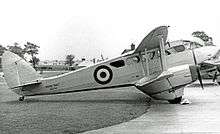
At the start of World War II, many (Dragon) Rapides were impressed by the British armed forces and served under the name de Havilland Dominie, for passenger and communications duties. Over 500 more were built for military use, powered by improved Gipsy Queen engines, to bring total production to 731. The Dominies were mainly used by the Royal Air Force and Royal Navy for radio and navigation training. Postwar they were used as communications aircraft by Royal Naval air station flights.
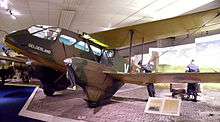
Other civilian Dragon Rapides continued to fly for UK airlines as part of the Associated Airways Joint Committee (AAJC). The AAJC co-ordinated the UKs wartime scheduled services which were entirely operated on over-water routes.
After the war, many ex-RAF survivors entered commercial service; in 1958, 81 examples were still flying on the British register. Dominie production was by de Havilland and Brush Coachworks Ltd, the latter making the greater proportion.
Postwar operations
_AN0230937.jpg)
The DH.89 proved an economical and durable aircraft, despite its relatively primitive plywood construction and many were still flying in the early 2000s. Several Dragon Rapides are operational in the UK and several operators including Classic Wings and Plane Heritage offer pleasure flights in them. After the Second World War de Havilland introduced a Dragon Rapide replacement, the de Havilland Dove.
Variants
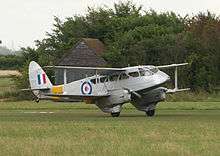
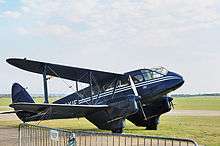
- D.H.89
- Twin-engined light transport biplane. First production version.
- D.H.89A
- Improved version, fitted with a landing light in the nose, modified wing tips and cabin heating.
- D.H.89A Series 4
- D.H.89A aircraft converted to two de Havilland Gipsy Queen 2 piston engines, fitted with constant speed propellers.[5][6]
- D.H.89A Mk 5
- One D.H.89A aircraft, powered by two de Havilland Gipsy Queen 3 piston engines, fitted with variable-pitch propellers.
- D.H.89A Mk 6
- One D.H.89A aircraft fitted with Fairey X5 fixed-pitch propellers.
- D.H.89M
- Military transport version. Exported to Lithuania and Spain.
- D.H.89B Dominie Mk I
- Radio and navigation training version.
- D.H.89B Dominie Mk II
- Communications and transport version.
Operators
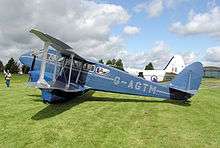
Civil

- Canadian Pacific
- Quebec Airways
- Misr Airlines
- Aero Oy operated two aircraft.
- Iranian State Airlines
- Aer Lingus
- Aer Turas operated one aircraft.
- Valsts Gaisa satiksme
- Air Travel (NZ) Ltd
- Mount Cook Airline
- National Airways Corporation
- Cook Strait Airways Ltd
- Palestine Airways (British Mandate of Palestine)
- Aviron
- Aerocarga Asociados ACA
- Comair (South Africa) operated 2 aircraft.
- Air Charter Limited
- Air Atlantique Classic Flight now the Classic Air Force
- Airviews Ltd
- Air Enterprises
- British Continental Airways
- British European Airways
- British Westpoint
- Classic Wings
- Crilly Airways Ltd
- Hillmans Airways
- Highland Airways
- Isle of Man Air Services
- Jersey Airways
- Lancashire Aircraft Corporation
- Mayflower Air Services
- Melba Airways
- Morton Air Services
- Northwest Airlines (UK)
- Olley Air Services
- Railway Air Services
- Scillonia Airways
- Scottish Airways
- Sivewright Airways
- Starways
- Trans European Aviation
- Westward Airways (Lands End)
Military operators
- Belgian Air Force (Seven operated from 1946)
- Luftwaffe operated captured aircraft.
- Lithuanian Air Force operated two D.H.89M aircraft.
- Royal Netherlands Air Force – four D.H.89B Mark II (transports)
- No. 334 Squadron RNLAF (1944–1956)
- Southern Rhodesian Air Force – Four aircraft.
- Spanish Republican Air Force operated three D.H.89M requisitioned from LAPE
- Royal Yugoslav Air Force – One aircraft impressed into military service in 1940.
Accidents and incidents
- 2 October 1934, G-ACPM of Hillman's Airways crashed into the sea off Folkestone, Kent causing the death of the pilot and the six passengers.[8]
- 30 December 1936, G-AEGS of the Iraqi Petroleum Petrol Transport Company overturned in a forced landing in Palestine, two killed.[8][9]
- 3 July 1938, G-AEBX Star of Scotia of Railway Air Services crashed at Sydenham, Northern Ireland, two killed.[8][9]
- 20 June 1939, G-AERE operated by British American Air Services crashed in County Durham, England.[10] John Crouch who was the king's jockey, the pilot and the wireless operator were all killed.[11]
- 27 May 1941, R5929 a Dominie of the Royal Air Force near Devizes, Wiltshire, England, seven killed.[8]
- 7 July 1941, R9563 a Dominie of the Royal Navy crashed in bad weather three miles North of Stonehaven, Aberdeenshire, Scotland, six killed.[8]
- 14 February 1942, R5927 a Dominie of the Royal Air Force hit a balloon cable and crashed near Colnbrook, Wiltshire, England, six killed.[8]
- 29 May 1942, VH-UXZ of Australian National Airways crashed near Flinders Island, Bass Strait, Australia following engine failure, four killed.[8]
- 6 February 1945, SU-ABP of Misr Airwork crashed in Egypt, seven killed.[8]
- 1 April 1946, G-AERZ of Railway Air Services crashed in County Down, Northern Ireland,[12] six killed.[8]
- 30 August 1946, X7394 a Dominie of the Royal Navy crashed at Scafell Pike, Cumberland, England in bad weather during an ambulance flight, five killed.[8]
- 15 April 1947, G-AHKR of British European Airways crashed into Slieu Ruy whilst operating a scheduled passenger flight from Speke Airport, Liverpool, Lancashire to Ronaldsway Airport, Isle of Man. There were only minor injuries amongst the six people on board.[13]
- 10 June 1948, G-AIUI of Hargreaves Airways crashed at Cronk ny Arrey Laa, Isle of Man. Seven of the nine people on board were killed. The aircraft was operating a scheduled passenger flight from Speke to Ronaldsway.[14]
- 11 November 1948, G-AKOF of Mannin Airways flying from Dublin, Ireland and unable to land at Ronaldsway diverted to Speke but ran out of fuel and crashed in River Mersey off Liverpool, England,[15][16] eight killed.[8]
- 10 July 1951, G-ALXJ of the Air Navigation and Trading Company crashed into the Irish Sea off Laxey, Isle of Man, killing the pilot. The aircraft was operating a scheduled cargo flight from Squires Gate Airport, Blackpool, Lancashire to RAF Jurby instead of its normal destination of Ronaldsway Airport, which was fogbound.[17]
- 14 September 1952, G-AIZI crashed shortly after take off from Croydon Airport at Wallington, Surrey following a loss of power from the starboard engine. The pilot, the only person on board, was killed. [18]
- 19 February 1954, G-AFMF crashed at Simonburn Common near Hexham, Northumberland. The pilot and seven passengers escaped with minor injuries.[19]
- 29 June 1957, G-AGUE of Island Air Services crashed on takeoff from Ramsgate Airport, Kent on a local pleasure flight. The aircraft was written off, but all on board escaped uninjured.[20]
- 16 July 1960, OY-DZY of Zonens Redningskorps crashed shortly after takeoff from Copenhagen Airport, Denmark. The aircraft was chartered by the Danish Football Association to transport soccer players to a test match in Jutland. All eight passengers were killed; the pilot survived but had one leg amputated.[21][22]
Surviving aircraft
- G-ADAH, a DH89A in the livery of Allied Airways, is on display at the Museum of Science and Industry in Manchester, England.[23]
- G-AEML / EC-AAY, a DH89A in the livery of Iberia, is airworthy and operated by the Fundación Infante de Orleans in Spain.[24]
- G-AGJG, a DH89A, in the colours of Scottish Airways, is airworthy and in the hands of private owners at Duxford Airfield, Cambridge, England.[25]
- G-AGTM, a DH89A, is airworthy and was operated by the Classic Air Force before it closed in 2016.[26]
- G-AHAG, a DH89A in the livery of Scillonia Airways, is airworthy and based at Membury airfield, Berkshire.[27]
- G-AIDL, a DH98A Mk 6, is airworthy and flown from the Tangmere Military Aviation Museum in Tangmere, West Sussex.[28]
- G-AKIF and G-AIYR, a pair of DH89A Dragon Rapides, are airworthy and based at Duxford, England airfield for tourist flights.[29]
- NR695 / N2290F, a DH89A, is on display at the National Museum of the United States Air Force, Dayton, Ohio.[30]
- TC-ERK, a DH89A, is on display at the Istanbul Aviation Museum.[31]
- ZS-JGV (CN8931), a DH89A is airworthy and is based in Queenstown in the Eastern Cape, South Africa.[32][33]
Specifications (Dragon Rapide)

General characteristics
- Crew: 1
- Capacity: 8 passengers
- Length: 34 ft 6 in (10.5 m)
- Wingspan: 48 ft 0 in (14.6 m)
- Height: 10 ft 3 in (3.1 m)
- Wing area: 340 ft² (32 m²)
- Empty weight: 3,230 lb (1,460 kg)
- Loaded weight: 5,500 lb (2,490 kg)
- Powerplant: 2 × de Havilland Gipsy Six inline engine, 200 hp (149 kW) each
Performance
- Maximum speed: 157 mph (136 kn, 253 km/h) at 1,000 ft (305 m)
- Range: 573 mi (498 nmi, 920 km)
- Service ceiling: 16,700 ft (5,090 m)
- Rate of climb: 867 ft/min (4.3 m/s)
- Wing loading: 16 lb/ft² (79 kg/m²)
- Power/mass: 0.036 hp/lb (60 W/kg)
Notable appearances in media
A 1986 Spanish film, Dragon Rapide,[34] covers its historical use by Generalissimo Francisco Franco during the preparation for the Spanish Civil War.[35]
See also
- Related development
- Related lists
References
Notes
- ↑ Jackson, 1978, pp.362–363
- ↑ Pigott 2005, p. 149.
- ↑ Alpert, Michael BBC History Magazine April 2002
- ↑ "Dragon Rapide G-AIDL". Tangmere Military Aviation Museum. 16 July 2009. Retrieved 13 May 2013.
- ↑ "Rapide Revival Flight p. 602, 30 October 1953
- ↑ "Rapide with Royal Urge", Flight: 676–677, 20 November 1953
- ↑ "Spanish Civil War Aircraft". Retrieved 2012-04-14.
- 1 2 3 4 5 6 7 8 9 10 11 "DH.89 Dragon Rapide" (PDF). Air-Britain.
- 1 2 Jackson 1973, p. 462
- ↑ "King's jockey is in missing plane". Dundee Courier (26847). 21 June 1939. p. 7 – via British Newspaper Archive. (subscription required (help)).
- ↑ Henderson, Tony (6 November 2013). "Auction revives memory of jockey's death in County Durham plane crash". The Journal. Archived from the original on 13 November 2014.
- ↑ Jackson 1973, p. 463
- ↑ Poole 1999, pp. 120–21.
- ↑ Poole 1999, pp. 121–22.
- ↑ Jackson 1973, p. 468
- ↑ "Mersey Accident", Flight: 595, 18 November 1948
- ↑ Poole 1999, pp. 126–27.
- ↑ http://publicapps.caa.co.uk/docs/HistoricalMaterial/G-AIZI.pdf
- ↑ ASN Aircraft accident 19-FEB-1954 de Havilland DH.89A Dragon Rapide G-AFMF, accessed 8 November 2011.
- ↑ Humphreys 2001, p. 169.
- ↑ "I dag er et trist jubilæum for dansk fodbold", Politiken, 16 July 2010, accessed 9 September 2011.
- ↑ CNAPG Dragon Rapide Individual Aircraft History Page, accessed 9 September 2011.
- ↑ "G-ADAH". airport-data.com. Retrieved 29 May 2016.
- ↑ "De Havilland 89 Dragon Rapide". fio.es. Retrieved 29 May 2016.
- ↑ Civil Aviation Authority (United Kingdom) (27 November 2016). "GINFO Search Results Summary". Retrieved 27 November 2016.
- ↑ "de Havilland DH89A Dragon Rapide 'G-AGTM'". flickr.com. Retrieved 29 May 2016.
- ↑ "Dragon Rapide Scillonia Airways" Retrieved: 16 November 2015.
- ↑ "DRAGON RAPIDE G-AIDL". tangmere-museum.org.uk. Retrieved 29 May 2016.
- ↑ Luke Mowatt & Peter Davison. "Dragon Rapide at Duxford". duxfordflying.co.uk. Retrieved 10 May 2016.
- ↑ "De Havilland DH 89 Dominie." National Museum of the US Air Force. Retrieved: 24 August 2015.
- ↑ "Hava Kuvvetleri Muzesi Komutanligi (Turkish Air Force Museum) - Yesilkoy - Istanbul - Turkey". aviationmuseum.eu. Retrieved 28 May 2016.
- ↑ Historic Wings Collection. Retrieved: 25 June 2016.
- ↑ dehavilland.co.za Retrieved: 25 June 2016.
- ↑ The Janus Museum (26 October 2007). "The Captain's Paradise". Archived from the original on 16 May 2008. Retrieved 1 June 2015.
- ↑ "Dragón Rapide". IMDB. Retrieved 1 June 2015.
Bibliography
- Fresson, Ted (May 2008). Air Road to the Isles. Erskine: Kea Publishing. ISBN 978-0951895894.
- Hamlin, John F. The De Havilland Dragon Rapide Family. Tunbridge Wells, Kent, UK: Air-Britain (Historians) Ltd., 2003. ISBN 0-85130-344-7.
- Humphreys, Roy (2001). Kent Aviation, A Century of Flight. Stroud: Sutton Publishing. ISBN 0-7509-2790-9.
- Jackson, A.J. De Havilland Aircraft since 1909. 1978. Putnam & Company Ltd. ISBN 0-370-30022-X
- Jackson, A.J. British Civil Aircraft 1919–1972: Volume II. London: Putnam (Conway Maritime Press), 1988. ISBN 0-85177-813-5
- Pigott, Peter. Royal transport : an inside look at the history of royal travel Toronto, Canada: Dundurn Group Publishing, 2005. ISBN 9781554882854.
- Poole, Stephen (1999). Rough Landing or Fatal Flight. Douglas: Amulree Publications. ISBN 1-901508-03-X.
External links
| Wikimedia Commons has media related to de Havilland Dragon Rapide. |